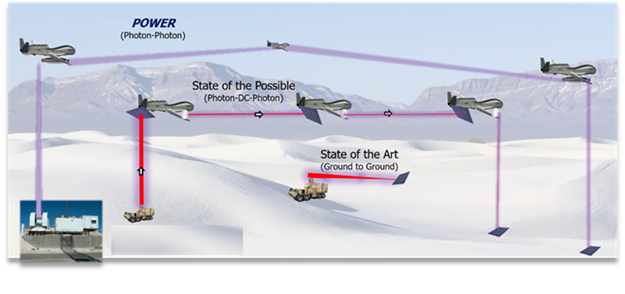
DARPA is entering the first phase of its Persistent Optical Wireless Energy Relay program (POWER) which will seek to power an entire drone swarm – including its directed-energy weapons – using lasers.
According to DARPA’s 2022 Broad Agency Announcement, the POWER program will “leverage power beaming for near-instantaneous energy transport to enable a resilient, multi-path energy network.” The program will attempt to design and demonstrate effective airborne optical energy relays which will be used to create a wireless energy web. This web would integrate ground-sourced lasers onto existing platforms to provide long-distance transmission through multiple airborne nodes and back down to a ground receiver.
“This project has the potential to advance power beaming by orders of magnitude, which could radically reshape society’s relationship with energy,” said Dr. Paul Jaffe, leader of the POWER program at DARPA. “A wireless energy web could unlock power from new and diverse sources, including from space, and rapidly and reliably connect them to energy-starved consumers.”
Raytheon, Draper and BEAM Co, will be working on the project.
“Under the two-year contract, Raytheon will create an airborne relay design to enable ‘webs’ capable of harvesting, transmitting and redirecting optical beams. These ‘webs’ will transmit energy from ground sources to high altitude for the precision, long-range operation of unmanned systems, sensors and effectors,” Raytheon recently announced.
According to DARPA, “Offboarding energy storage and generation from platforms opens up a novel design space where platform capabilities are no longer dependent on the quantity of fuel carried. This provides an opportunity for small, inexpensive distributed platforms with significant capabilities such as unlimited range or endurance.”
“Each of the selected teams proposed unique technical approaches to the power beaming relay problem, ranging from novel combinations of existing technologies to high-risk, high-reward technological innovations,” said Jaffe. “The range of proposed solutions encompasses a balance of assured performance and potential breakthroughs in size, weight, and power to enable small distributed systems for the future wireless energy web.”
